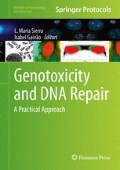Abstract
Nanogenotoxicology is an emergent area of research aiming to determine the potential risk of nanomaterials. Since most of the established studies use in vitro approaches, neglecting the repair and metabolic properties of the whole organism, some doubts about the accuracy of the obtained results exist. To overcome this gap more in vivo approaches testing the potential genotoxic risk of nanomaterials are required. In this context we propose to use Drosophila melanogaster as a useful model to study the possible genotoxic risk associated to nanoparticles exposure. Until now, only few studies have been carried out and they all use the wing-spot assay that detects the induction of somatic mutation and recombination events in the wing imaginal disks. This test is based on the principle that the loss of heterozygosis and the corresponding expression of the suitable recessive markers, multiple wing hairs and flare-3, can lead to the formation of mutant clone cells in growing up larvae, which are expressed as mutant spots on the wings of adult flies. The protocol to perform the wing-spot assay is presented.
Access this chapter
Tax calculation will be finalised at checkout
Purchases are for personal use only
References
Fubini B, Ghiazza M, Fenoglio I (2010) Physico-chemical features of engineered nanoparticles relevant to their toxicity. Nanotoxicology 4:347–363
Medina C, Santos-Martinez MJ, Radomski A et al (2007) Nanoparticles: pharmacological and toxicological significance. Br J Pharmacol 150:552–558
Oberdorster G, Oberdorster E, Oberdorster J (2005) Nanotoxicology: an emerging discipline evolving from studies of ultrafine particles. Environ Health Perspect 113:823–839
Casey A, Herzog E, Lyng FM et al (2008) Single walled carbon nanotubes induce indirect cytotoxicity by medium depletion in A549 lung cells. Toxicol Lett 179:78–84
Rahman MF, Wang J, Patterson TA et al (2009) Expression of genes related to oxidative stress in the mouse brain after exposure to silver nanoparticles. Toxicol Lett 187:15–21
Pan X, Redding JE, Wiley PA et al (2010) Mutagenicity evaluation of metal oxide nanoparticles by the bacterial reverse mutation assay. Chemosphere 79:113–116
Nel A, Xia T, Madler L et al (2006) Toxic potential of materials at the nanolevel. Science 311:622–627
Donaldson K, Stone V, Tran CL et al (2004) Nanotoxicology. Occup Environ Med 61:727–728
Colvin VL (2003) The potential environmental impact of engineered nanomaterials. Nat Biotechnol 21:1166–1170
Rand MD (2010) Drosophotoxicology: the growing potential for Drosophila in neurotoxicology. Neurotoxicol Teratol 32:74–83
Reiter LT, Potocki L, Chien S et al (2001) A systematic analysis of human disease-associated gene sequences in Drosophila melanogaster. Genome Res 11:1114–1125
Koh K, Evans JM, Hendricks JC et al (2006) A Drosophila model for age associated changes in sleep: wake cycles. Proc Natl Acad Sci U S A 103:13843–13847
Wolf MJ, Amrein H, Izatt JA et al (2006) Drosophila as a model for the identification of genes causing adult human heart disease. Proc Natl Acad Sci U S A 103:1394–1399
Khurana V, Lu Y, Steinhilb ML et al (2006) TOR-mediated cell-cycle activation causes neurodegeneration in a Drosophila tauopathy model. Curr Biol 16:230–241
Pandey A, Chandra S, Chauhan LK et al (2013) Cellular internalization and stress response of ingested amorphous silica nanoparticles in the midgut of Drosophila melanogaster. Biochim Biophys Acta 1830:2256–2266
Wang B, Chen N, Wei Y et al (2012) Akt signaling-associated metabolic effects of dietary gold nanoparticles in Drosophila. Sci Rep 2:563
Vecchio G, Galeone A, Brunetti V et al (2012) Concentration-dependent, size-independent toxicity of citrate capped AuNPs in Drosophila melanogaster. PLoS One 7:e29980
Gorth DJ, Rand DM, Webster TJ (2011) Silver nanoparticle toxicity in Drosophila: size does matter. Int J Nanomedicine 6:343–350
Posgai R, Cipolla-McCulloch CB, Murphy KR et al (2011) Differential toxicity of silver and titanium dioxide nanoparticles on Drosophila melanogaster development, reproductive effort, and viability: size, coatings and antioxidants matter. Chemosphere 85:34–42
Liu X, Vinson D, Abt D et al (2009) Differential toxicity of carbon nanomaterials in Drosophila: larval dietary uptake is benign, but adult exposure causes locomotor impairment and mortality. Environ Sci Technol 43:6357–6363
Galeone A, Vecchio G, Malvindi MA et al (2012) In vivo assessment of CdSe-ZnS quantum dots: coating dependent bioaccumulation and genotoxicity. Nanoscale 4:6401–6407
Demir E, Vales G, Kaya B et al (2011) Genotoxic analysis of silver nanoparticles in Drosophila. Nanotoxicology 5:417–424
Vales G, Demir E, Kaya B et al (2013) Genotoxicity of cobalt nanoparticles and ions in Drosophila. Nanotoxicology 7:462–468
Demir E, Turna F, Vales G et al (2013) In vivo genotoxicity assessment of titanium, zirconium and aluminium nanoparticles, and their microparticulated forms, in Drosophila. Chemosphere 93:2304–2310
de Andrade LR, Brito AS, Melero AM et al (2014) Absence of mutagenic and recombinagenic activity of multi-walled carbon nanotubes in the Drosophila wing-spot test and Allium cepa test. Ecotoxicol Environ Saf 99:92–97
Graf U, Würgler FE, Katz AJ et al (1984) Somatic mutation and recombination test in Drosophila melanogaster. Environ Mutagen 6:153–188
Lindsley DL, Zimm GG (1992) The Genome of Drosophila melanogaster. Academic, San Diego
Kastenbaum MA, Bowman KO (1970) Tables for determining the statistical significance of mutation frequencies. Mutat Res 9:527–549
Frei H, Würgler FE (1988) Statistical methods to decide whether mutagenicity test data from Drosophila assays indicate a positive, negative, or inconclusive result. Mutat Res 203:297–308
Alonso-Moraga A, Graf U (1989) Genotoxicity testing of antiparasitic nitrofurans in the Drosophila wing somatic mutation and recombination test. Mutagenesis 4:105–110
Acknowledgments
The authors thank the financial support of their research activity by CIRIT (project 2009SGR-725). BA was supported by a postdoctoral fellowship from the Universitat Autònoma de Barcelona (UAB). MAA was supported by a predoctoral fellowship from the Egyptian Government.
Author information
Authors and Affiliations
Corresponding author
Editor information
Editors and Affiliations
Rights and permissions
Copyright information
© 2014 Springer Science+Business Media New York
About this protocol
Cite this protocol
Abdalaziz, M.A., Annangi, B., Marcos, R. (2014). Testing the Genotoxic Potential of Nanomaterials Using Drosophila. In: Sierra, L., Gaivão, I. (eds) Genotoxicity and DNA Repair. Methods in Pharmacology and Toxicology. Humana Press, New York, NY. https://doi.org/10.1007/978-1-4939-1068-7_17
Download citation
DOI: https://doi.org/10.1007/978-1-4939-1068-7_17
Published:
Publisher Name: Humana Press, New York, NY
Print ISBN: 978-1-4939-1067-0
Online ISBN: 978-1-4939-1068-7
eBook Packages: Springer Protocols

